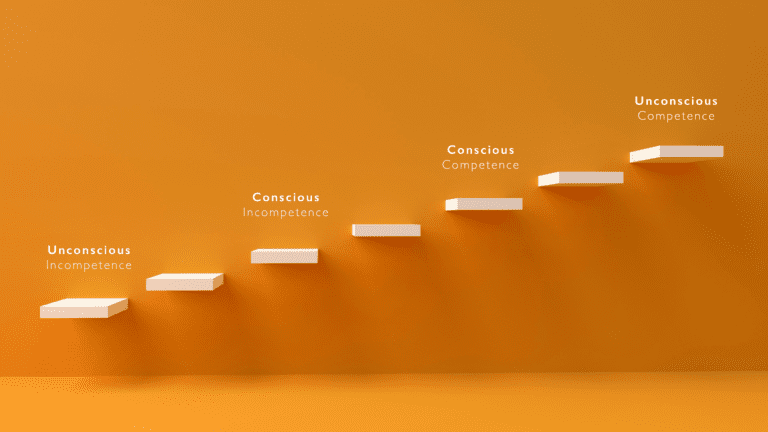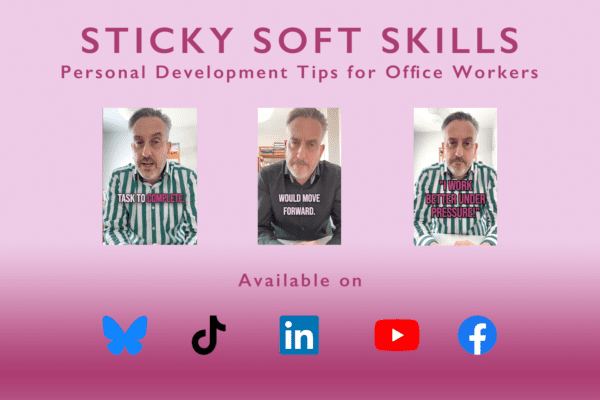Hurdle #1: Getting An Idea of What You Don’t Know
Learning something new can be an exciting challenge or a daunting uphill struggle. It depends on what we want to learn, who we have supporting us, and what basic idea we think we know on the topic or skill to begin with. But how much do we REALLY know at the very beginning? The answer is not a lot and we’re usually not even aware that we don’t know. This is unconscious incompetence and is what we are going to be looking at in this article. Think of the catchphrase “Fake it till you make it”. Is that really the way forward?
Take a skill you’ve probably seen lots of times before on TV or in movies, like karate kicks or tossing a pizza dough in the air and catching it. I’ve seen it done, surely it can’t be that hard! Right? Well, that’s where our article today will take us on a journey of realisation and highlight the very important, and often, difficult first step of learning – figuring out that there are things about this new skill that we really don’t know.
Here, we’re going to take you through key elements of the topic of unconscious incompetence.
- What is Unconscious Incompetence?
- What are the 4 Levels of Learning?
- Unconscious Incompetence in Action – My Example
- Common Examples of Unconscious Incompetence
- How to Jump the Hurdle of Unconscious Incompetence
Join us on this adventure to cross that first hurdle of learning and get us to master skills and knowledge we didn’t think possible.

What is Unconscious Incompetence?
Having first appeared in the 1960s, we trace the origins of this model back to a management textbook called “Management of Training Programs” from 1960 written by 3 New York University management professors, Frank A. DePhillips, William M. Berliner and James J. Cribbin. Next, we see the reference from management coach Martin. M Broadwell. His model was based on teachers at different levels of competence in the classroom. His model identified that when we learn something new, we travel through 4 distinctive levels of competence. The starting point can be the most difficult level to move forward from. Also known as the “ignorance” level, this is the launch pad for learning anything new.
Albert Einstein once said: “Incompetence is the true crisis”. Now, add unawareness or unconsciousness to that, you’re heading for disaster as a company. Undoubtedly, you have people in your team suffering from this level of incompetence and it is damaging your business. Let’s take a closer look.
The 4 Levels of Competence Explained
This model explains the different phases we pass through during the learning process. Here they are.
- Unconscious Incompetence – Ignorance, lack of awareness – I don’t know what I don’t know
- Conscious Incompetence – Awareness, but lacking know-how – I know what I don’t know
- Conscious Competence – Awareness and some know-how with effort – I know and can do but need to concentrate
- Unconscious Competence – Mastery, effortless – I know and can do as second nature
Here, we find the steps or ladder of learning new things.

Sticky Learning ® is 7 times more effective than 1-day training courses. Plus, you will get a Chain of Evidence proving your Return on Investment. Discover soft skills training that changes behaviours long term.

#1: Unconscious Incompetence
First, we have the “ignorance” stage of learning. We really don’t know what we don’t know. Well, how could we really? Nobody showed us or taught us anything yet! Well, most of you have probably learned how to drive a car. So, that first driving lesson creates a much better understanding of everything it will take to drive a car and pass your test. This stage can be challenging for a number of reasons. People often:
- Ignore the fact that we require further skills or knowledge
- Resist further learning
- Resent being told that they don’t know something
- Get stuck at this level due to a lack of direction or guidance
It is your responsibility to get them across the first hurdle and challenge their own ignorance.
#2: Conscious Incompetence
Next, we have awareness occurring. We realise that there are things we don’t know that we need to know. Importantly, this stage creates the platform for change. The ability to answer questions or complete a task doesn’t exist. However, the individual knows that the skill or knowledge is essential for moving forward. Also known as the “awareness” stage, it allows us to move forward in learning by recognising that gaps exist in terms of our levels of competence.
So, your sales reps now know what’s missing in their knowledge of the product or service they are selling. However, they don’t yet have the competence to sell the item to clinch the deal with the customer.
At this level,
- Encourage conversations about what gaps exist
- Promote future learning opportunities
- Conduct gap analysis for each member, creating more awareness
- Support them in their journey
#3: Conscious Competence
Here, we reach a level of understanding and competence through training and experience. Our skills and knowledge are at a competent level. However, effort is required to complete the tasks. For example, your sales rep is completing a pitch with potential customers, but they still need their notes for reference.
At this stage, we see some inconsistencies in our performance and end result when effort is not made to achieve the right result. We apply proper focus and attention to get the best results, but we still cannot complete the tasks without full concentration.
For this level,
- Identify additional steps that lead to mastery of the task
- Provide ongoing supportive feedback
- Acknowledge progress
- Complete assessments to check for understanding
#4: Unconscious Competence
Finally, we are now the masters and have the consistency required to deliver the same result every time. Here, it has become second nature. You don’t require extra effort to do the job. Instead, it is second nature to us. So, your sales reps are now fully fluent about the product or service and make the sales pitch with ease.
At this level,
- Use your “masters” to develop and train others
- Recoginse and praise their levels of competence and skills
- Encourage others to follow their lead
One good reference to the competency stages comes from the book “The Dynamics of Life Skills Coaching” by Paul R. Curtis and Phillip W. Warren (1973) where they describe the competency levels as follows:
“Unconscious incompetence” where you are not skilled but do not realise it. Upon exposure to the training, you will feel “conscious incompetence” where you recognize your lacks but have not increased your skills to any great extent; this is a particularly frustrating phase. With practice, you feel “conscious competence” where the skills are painfully obvious and undeveloped, and you feel embarrassed at your attempts and the lack of smooth and polished performance. With practice, you attain “unconscious competence” where the skills learned so painfully seem to be a natural part of your life and you feel “naturally competent”. (p.89)
I’m sure from looking at their description that we can each place ourselves at those different levels numerous times through our own careers.
Unconscious Incompetence in Action – My Example
I can share my example with you to try to paint a picture of what it looks like and how it feels. Bear with me while I take you through memory lane, well my lane at least, to explain the feeling of unconsciousness incompetence in action.
Dublin, Ireland

While studying Hotel and Catering Management in college in Dublin, Ireland, I had part-time work as a waitress at a top 5* golf resort. During those 3 years of studies, I really felt that I would be a world-class Food & Beverage Director in the future. However, in my final year of college, there was a guest lecturer coming to speak to the first years. In fact, he was the General Manager of the 5* golf resort I mentioned just now, and I requested to sit in on his lecture to hear what he had to say. Now, remember, we’re talking about the 90s, and he dropped a bombshell on me – during his talk he mentioned that all General Managers at the time were only really successful if they had rooms division and revenue management experience.
Well, there went my plans for becoming the top F&B Director the world has ever seen. Because, ideally, I did have my sights, at the time, of one day holding the position of General Manager. So, change of plans. Before finishing college, I applied to 4 hotels in central London, not in the food and beverage department but as a receptionist. I was thinking that if I had to start from the beginning that’s what I would do to reach my general manager goal. Anyway, how hard could it really be, right? Just stand or sit there at the reception desk, smile, hand over keys and settle bills. Easy-peasy – bring it on!
Central London

On my first day on the job at my hotel in London as a receptionist, I got the biggest wake-up call of my young life. Wow, these guys did a lot more than I thought. I had no idea of the amount of work and variety of different tasks that were involved in doing a guest check-in or check-out. The registration for the guest alone took multiple steps and processes and was quite daunting. I had no idea when I applied for the job how little I knew about what the Front Office team really do. And that’s even before we start talking about all the financial transactions, data entry, or the dreaded guest complaints! And don’t get me started on the vast encyclopedia of information they needed to know about, not just our hotel, but the surrounding areas, tourist attractions and so on…
Suffice it to say, leaving that first shift on my first day on the job, I had a newfound respect for the complexity of the new role I was about to learn and the new career I was embarking on. And that was a very clear memory of my unconscious incompetence at the start of my 25+ years to date in hospitality….. Any of you thinking back about starting out in your first job on that first day will probably connect with that experience and how that felt.
Common Examples of Unconscious Incompetence
There are many situations where we can see unconscious incompetence occurring that we should be aware of.
- The brand-new employee – those starting on the job with no experience and learning from scratch
- Students coming for internship or work experience at your company
- Customers trying a new product or service for the first time
- Staff who have been newly promoted to a higher position without on-the-job training or exposure
- People from other departments, without the knowledge or skills in your field, questioning your actions or decisions
- Sales reps, without the proper knowledge of the product or service, heading a sales pitch to potential consumers.
It is important, as leaders, to know these situations and be ready to help create awareness. Remember, they don’t know that they don’t know. You are their guide and support to the next step of the ladder.
How to Jump the Hurdle of Unconscious Incompetence
So, how can we overcome the first hurdle of learning and start to know what we don’t know. Here are some practical steps to get you going.
#1: Create Awareness
First, you need to help people move on from that first unconscious incompetence step of learning. So, create awareness for people of skills and knowledge that are required for a particular role in your team or company. Next, have clear guidelines. Show what is required to complete each step, such as your departmental SOPs (Standard Operating Procedures). Also, ensure all new joiners have clear job descriptions and roles and duties explained from the first day.
#2: Provide Effective Training
Next, ensure training sessions are available. Include on-the-job training and “buddy” systems for new joiners in their induction plan. Also, provide refresher training as required. For all new products and services, ensure proper training activities are happening for everyone involved. Then, promote and encourage learning activities that involve everyone in the team who is required to know what they previously didn’t know. Use experienced members of the team during these activities as they can support the new learners.
#3: Conduct Regular Checks
Here, check that everyone who needs to know the job knows what they need to know. In other words, ask questions of the team. Check through assessments or brief questions and answers sessions during meetings that the awareness is there. Otherwise, people are caught in that first step of unconscious incompetence. This hurts your team’s performance. Also, it damages the reputation of your team who are making mistakes and unable to perform as per the required standards.
#4: Encourage Exposure to Skills and Knowledge
Additionally, encourage your team to have exposure to areas of learning and growth. Training is great, however, some hands-on experience will reinforce the learning activity. As we in the Learning & Development community know, we all learn better by doing. So, have first-hand experience opportunities available. For example, for a new sales rep, send them out with an experienced member of your team on sales calls to see how it’s done.
#5: Support Others at the First Step
Finally, avoid getting frustrated with your unconscious incompetent team members. Remember, they don’t know that they don’t know. Or they don’t properly understand the need to know. Here, guide them through the process. Instead, we explain what is needed and why. Also, we support them over that first hurdle. Expose the team to the areas that they don’t know but need to.
Summary
Moving forward, embrace the first step of learning by putting the above-mentioned steps into practice. You will see the difference in your team once you do. Remember, there’s nothing wrong with being on the first step of the learning ladder, we’ve all been there. However, avoid people getting stuck there as a result of inaction.
At MBM we have various resources available regarding coaching and learning that can help. Check out our wide-ranged catalogue of blog articles dealing with the topics of learning, development, and personal growth. Also, have a look at our range of 30+ different coaching card decks that can help you and your team move forward. Don’t get stuck on the first step with unconscious incompetence. Instead, move forward, grow and learn to become the masters of your team and company.





